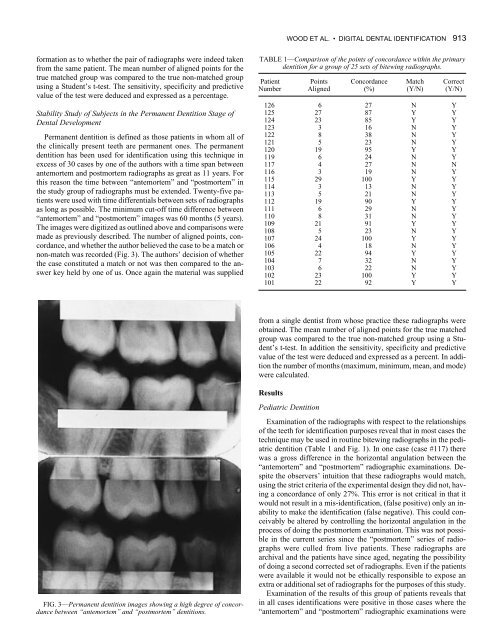Digital dental radiographic identification in the pediatric ... - Library
Digital dental radiographic identification in the pediatric ... - Library
Digital dental radiographic identification in the pediatric ... - Library
You also want an ePaper? Increase the reach of your titles
YUMPU automatically turns print PDFs into web optimized ePapers that Google loves.
formation as to whe<strong>the</strong>r <strong>the</strong> pair of radiographs were <strong>in</strong>deed taken<br />
from <strong>the</strong> same patient. The mean number of aligned po<strong>in</strong>ts for <strong>the</strong><br />
true matched group was compared to <strong>the</strong> true non-matched group<br />
us<strong>in</strong>g a Student’s t-test. The sensitivity, specificity and predictive<br />
value of <strong>the</strong> test were deduced and expressed as a percentage.<br />
Stability Study of Subjects <strong>in</strong> <strong>the</strong> Permanent Dentition Stage of<br />
Dental Development<br />
Permanent dentition is def<strong>in</strong>ed as those patients <strong>in</strong> whom all of<br />
<strong>the</strong> cl<strong>in</strong>ically present teeth are permanent ones. The permanent<br />
dentition has been used for <strong>identification</strong> us<strong>in</strong>g this technique <strong>in</strong><br />
excess of 30 cases by one of <strong>the</strong> authors with a time span between<br />
antemortem and postmortem radiographs as great as 11 years. For<br />
this reason <strong>the</strong> time between “antemortem” and “postmortem” <strong>in</strong><br />
<strong>the</strong> study group of radiographs must be extended. Twenty-five patients<br />
were used with time differentials between sets of radiographs<br />
as long as possible. The m<strong>in</strong>imum cut-off time difference between<br />
“antemortem” and “postmortem” images was 60 months (5 years).<br />
The images were digitized as outl<strong>in</strong>ed above and comparisons were<br />
made as previously described. The number of aligned po<strong>in</strong>ts, concordance,<br />
and whe<strong>the</strong>r <strong>the</strong> author believed <strong>the</strong> case to be a match or<br />
non-match was recorded (Fig. 3). The authors’ decision of whe<strong>the</strong>r<br />
<strong>the</strong> case constituted a match or not was <strong>the</strong>n compared to <strong>the</strong> answer<br />
key held by one of us. Once aga<strong>in</strong> <strong>the</strong> material was supplied<br />
FIG. 3—Permanent dentition images show<strong>in</strong>g a high degree of concordance<br />
between “antemortem” and “postmortem” dentitions.<br />
from a s<strong>in</strong>gle dentist from whose practice <strong>the</strong>se radiographs were<br />
obta<strong>in</strong>ed. The mean number of aligned po<strong>in</strong>ts for <strong>the</strong> true matched<br />
group was compared to <strong>the</strong> true non-matched group us<strong>in</strong>g a Student’s<br />
t-test. In addition <strong>the</strong> sensitivity, specificity and predictive<br />
value of <strong>the</strong> test were deduced and expressed as a percent. In addition<br />
<strong>the</strong> number of months (maximum, m<strong>in</strong>imum, mean, and mode)<br />
were calculated.<br />
Results<br />
WOOD ET AL. • DIGITAL DENTAL IDENTIFICATION 913<br />
TABLE 1—Comparison of <strong>the</strong> po<strong>in</strong>ts of concordance with<strong>in</strong> <strong>the</strong> primary<br />
dentition for a group of 25 sets of bitew<strong>in</strong>g radiographs.<br />
Patient Po<strong>in</strong>ts Concordance Match Correct<br />
Number Aligned (%) (Y/N) (Y/N)<br />
126 6 27 N Y<br />
125 27 87 Y Y<br />
124 23 85 Y Y<br />
123 3 16 N Y<br />
122 8 38 N Y<br />
121 5 23 N Y<br />
120 19 95 Y Y<br />
119 6 24 N Y<br />
117 4 27 N N<br />
116 3 19 N Y<br />
115 29 100 Y Y<br />
114 3 13 N Y<br />
113 5 21 N Y<br />
112 19 90 Y Y<br />
111 6 29 N Y<br />
110 8 31 N Y<br />
109 21 91 Y Y<br />
108 5 23 N Y<br />
107 24 100 Y Y<br />
106 4 18 N Y<br />
105 22 94 Y Y<br />
104 7 32 N Y<br />
103 6 22 N Y<br />
102 23 100 Y Y<br />
101 22 92 Y Y<br />
Pediatric Dentition<br />
Exam<strong>in</strong>ation of <strong>the</strong> radiographs with respect to <strong>the</strong> relationships<br />
of <strong>the</strong> teeth for <strong>identification</strong> purposes reveal that <strong>in</strong> most cases <strong>the</strong><br />
technique may be used <strong>in</strong> rout<strong>in</strong>e bitew<strong>in</strong>g radiographs <strong>in</strong> <strong>the</strong> <strong>pediatric</strong><br />
dentition (Table 1 and Fig. 1). In one case (case #117) <strong>the</strong>re<br />
was a gross difference <strong>in</strong> <strong>the</strong> horizontal angulation between <strong>the</strong><br />
“antemortem” and “postmortem” <strong>radiographic</strong> exam<strong>in</strong>ations. Despite<br />
<strong>the</strong> observers’ <strong>in</strong>tuition that <strong>the</strong>se radiographs would match,<br />
us<strong>in</strong>g <strong>the</strong> strict criteria of <strong>the</strong> experimental design <strong>the</strong>y did not, hav<strong>in</strong>g<br />
a concordance of only 27%. This error is not critical <strong>in</strong> that it<br />
would not result <strong>in</strong> a mis-<strong>identification</strong>, (false positive) only an <strong>in</strong>ability<br />
to make <strong>the</strong> <strong>identification</strong> (false negative). This could conceivably<br />
be altered by controll<strong>in</strong>g <strong>the</strong> horizontal angulation <strong>in</strong> <strong>the</strong><br />
process of do<strong>in</strong>g <strong>the</strong> postmortem exam<strong>in</strong>ation. This was not possible<br />
<strong>in</strong> <strong>the</strong> current series s<strong>in</strong>ce <strong>the</strong> “postmortem” series of radiographs<br />
were culled from live patients. These radiographs are<br />
archival and <strong>the</strong> patients have s<strong>in</strong>ce aged, negat<strong>in</strong>g <strong>the</strong> possibility<br />
of do<strong>in</strong>g a second corrected set of radiographs. Even if <strong>the</strong> patients<br />
were available it would not be ethically responsible to expose an<br />
extra or additional set of radiographs for <strong>the</strong> purposes of this study.<br />
Exam<strong>in</strong>ation of <strong>the</strong> results of this group of patients reveals that<br />
<strong>in</strong> all cases <strong>identification</strong>s were positive <strong>in</strong> those cases where <strong>the</strong><br />
“antemortem” and “postmortem” <strong>radiographic</strong> exam<strong>in</strong>ations were

















